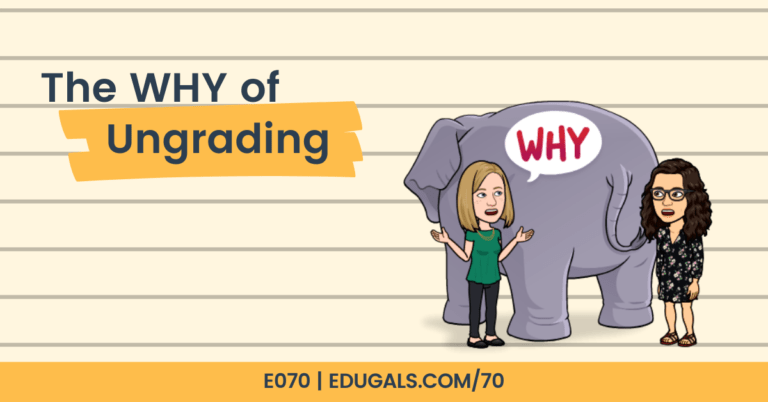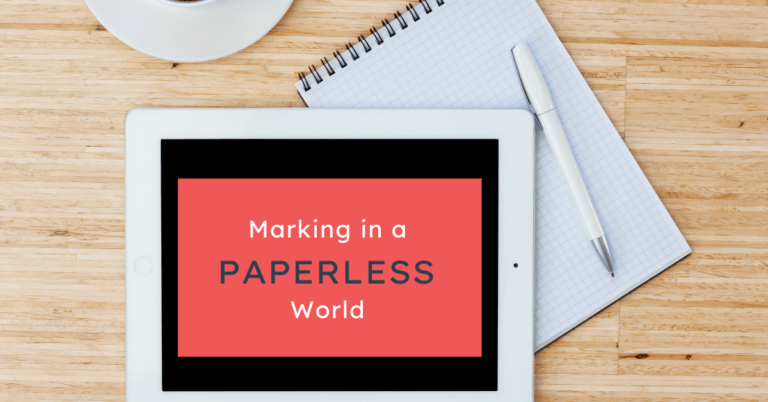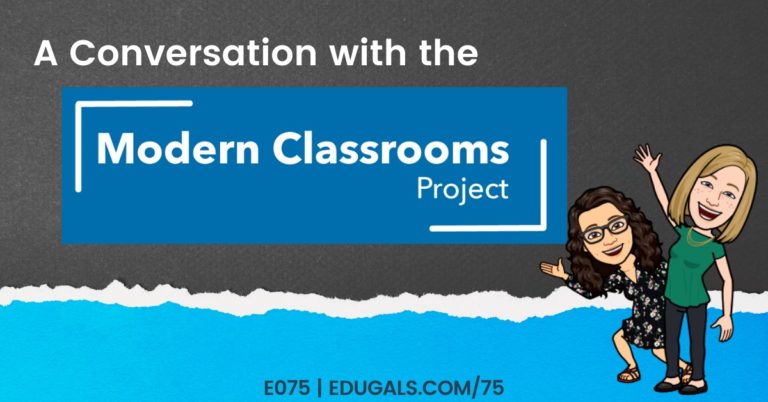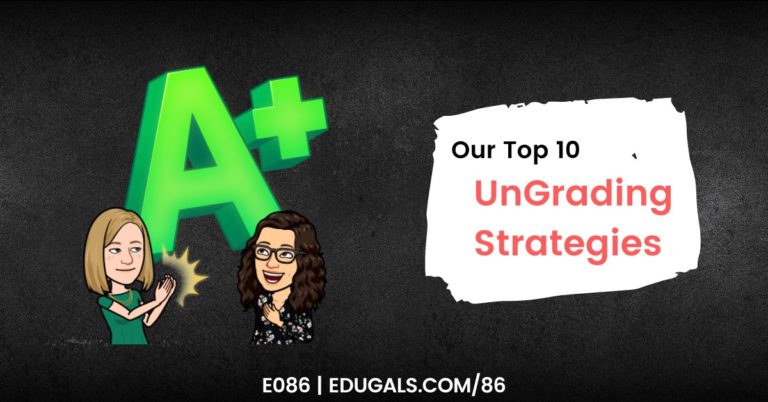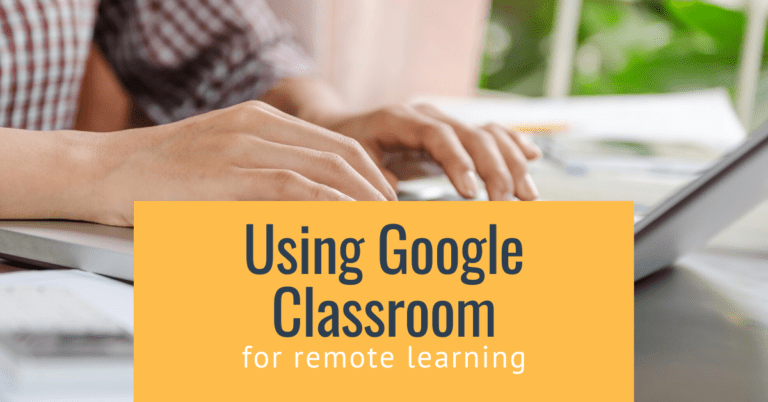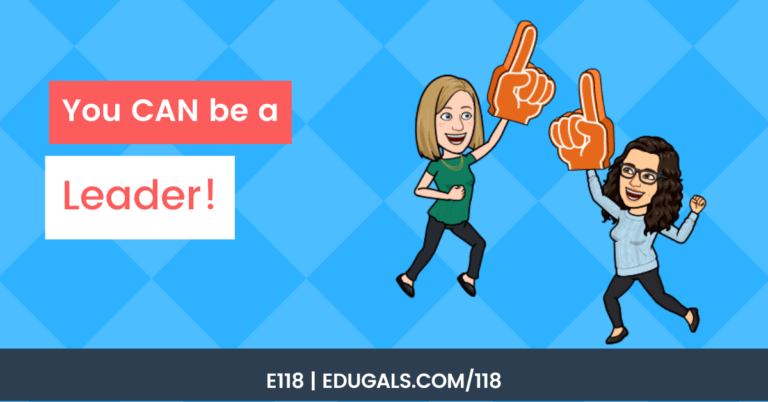Are you curious about how you can create mastery-based structures in your classroom? For example, how can we set up our classroom in such a way that students are demonstrating mastery of skills as they are working through the content in your courses versus dragging them along when they aren’t ready yet.
This format is a great way for students to develop their skills at their own pace, mastering skills based on their own individual needs, at a pace that makes sense to them.
Curious to learn more? Listen to our podcast episode below or continue reading!
This has become so important this year in particular! With all of the talk of “learning gaps” or “learning loss,” this format really helps us to meet our students where they are at, and work with them to move forward. We need to stop thinking about our courses with an attitude or belief that there is a specific starting point, and instead we need to be open to shifting that based on what our students know, and what they need to learn.
In reality, students haven’t really lost any learning. They perhaps didn’t learn as much as they would in a traditional learning environment, but they have still moved forward in their learning, and their skills. We just need to shift our mindset to meet them where they are.
Another idea or perspective to consider: just because you’re teaching it, are students really learning it?! If we, as educators, are checking off the list of lessons we have to deliver, but students aren’t getting it, have we really taught them?
The pandemic has really prompted this shift in thinking, and made us more reflective as educators and practitioners. This brings us to a quote by Maya Angelou, which Jake Miller often brings up:
Do the best you can until you know better. Then when you know better, do better.”
Maya Angelou
We, as educators, should really live by this message; once we learn how we can improve our teaching practice, we should embrace it and change the way we teach to reflect that new learning. This quote can also be used when we approach our learning around equity.
Rachel recently went to a webinar called: Beyond the Bohr Model, all about how to teach atomic structure in chemistry in a different way. It really has her thinking about how to incorporate this structure in her own teaching, with her own students. Check it out if you’re a chemistry teacher looking to find a different way of teaching this concept!

Where do You Start with Mastery-Based Learning?
It can be really overwhelming when you think about the idea of restructuring your entire course in order to implement mastery-based learning (or any new format, really).
Perhaps the best place to start is by discussing what mastery-based learning is, and what it can look like in the classroom.
What is Mastery-Based Learning?
Mastery-based classrooms is a set up where students are working on a skill in class until they have mastered that skill. Once they have mastered it, they then move on to the next skill.
Mastery for each teacher may look a little different; some teachers may set an expectation of understanding and demonstrating 80% of a skill, whereas for others it may be 100% of a skill – it is up to you!
The big idea here is that students aren’t moving on to a new skill, or adding a skill, until we know that students can understand and demonstrate the basics. From there, you are adding little by little, and building their skills. This way we ensure that students can understand and apply the skills they are learning before they move on.
It’s so important for all courses, particularly courses where the skills or knowledge builds as the course continues, such as in math or science courses. We often have students who get left behind in the classroom, because they aren’t really learning effectively the skills that are required in order to successfully complete the course, and then they move on to the next course or level without having the knowledge or skills base that they need to be successful. Mastery-based learning addresses this issue, and offers a solution.
That being said, one aspect of a mastery-based class that’s important to wrap your head around: not all students will be at the same point of the course at the same time. You have to be prepared to have students moving on while others are still working to solidify and master a different skill. That is, by far, the most challenging part of implementing this structure.
That being said, the self-paced structure of this classroom method lends itself quite naturally to the use of instructional videos. This way, students can be accessing new learning and progressing in the course without having to necessarily wait for the rest of the class.
While this all sounds wonderful and ideal, we need to address the fact that mastery-based learning can be very prep heavy at the beginning. Once it is done, though, you don’t have to worry about preparing the lessons or activities for the rest of the unit or course. Instead, you now have time to focus on supporting students! You can tweak and/or add as you go, but a lot of the leg work is already done. There will still be marking of assessments, giving feedback, etc. but the majority of the work to prepare the lessons is complete.
Start Small With Mastery-Based Learning!
Consider approaching one unit of your course and structuring it in this mastery-based approach. You could even consider starting with a single project or assignment! Students have to complete a step before they move on to the next step. It’s a great way to ensure they are following directions and demonstrating the skills or understanding necessary to be successful.
Recently, Katie had a perfectly-timed wake up call as to why this method needs to be embraced in her own teaching practice. In her sheltered Canadian history course (sheltered means it is a course for English language learners), she introduced a research project. She went over all of the steps and expectations, how to access databases, what they would then create with that info, etc. and let them get to work.
The issue? They all skipped the research and went directly to the final product: a presentation. The point of the project wasn’t a presentation, but rather it was the process involved in creating a presentation: how to find resources, how to cite, how to take notes in your own words, etc. However, because they knew the product was a presentation, they didn’t care for the process.
If she had introduced each step one at a time, not allowing students to move on until they demonstrated that they could understand and complete the first steps, it would have been a completely different outcome.
One suggestion to avoid this issue and to help students track expectations is a checklist. You may find that you need to add to the checklist as students are going through the process for the first time, but that’s okay! Sometimes it takes more steps than we anticipate, or the needs of the students are different and require additional descriptions that we didn’t expect. The big thing here is that the expectations are clear for the students.
In more content heavy courses, construct little mastery checks throughout. They can be super short (1-2 questions), and students take them when they are ready. If they haven’t mastered it, then they aren’t yet ready to move on, and will instead revisit a lesson, explore a different video or approach, sit down with the teacher for extra help, etc. before attempting a mastery check again.
In covid-free times, the physical layout of the classroom is an important factor to consider. You should have a dedicated space where students can complete the mastery checks. You can also use different coloured paper for different lessons, if you decide to go the paper route. This will help you to stay organized and know what each student is working on. You can then target those students that may require a bit of extra help or support in order to build and demonstrate mastery in a skill.
Plan in the Works: Katie’s Mastery-Based EAL
In Katie’s English as an Additional Language (EAL) courses, she will be mixing up the students, no longer putting students with similar language skills in the same course. There are a lot of benefits to mixing students of various skill levels, such as building connections with a greater variety of peers, pushing or encouraging one another to communicate or develop in various areas of language, and demonstrating language skills to those that are perhaps not as far along on their language journey.
The course will then be divided based on the strands from the curriculum: speaking and listening, reading, writing, sociocultural understanding, grammar. It will be similar to stations, but with a mastery approach. Students will be able to focus on the strand that they need a little more support with, while also still developing the other areas as well.
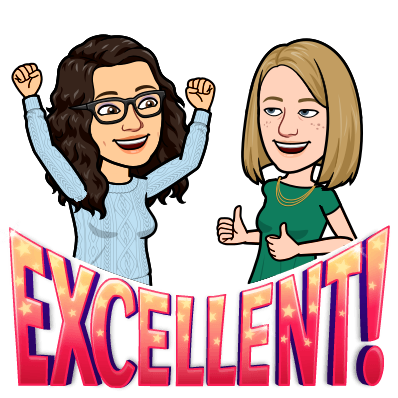
The best part?! Co-teaching! In our plan, we will be able to co-teach the students based on our strengths as teachers. This will expose our students to more teaching styles, accents, and approaches to language in a safe learning environment.
In the plan that we have, it is motivating for students to have a little more control over their learning, and their pace. There’s no reason why a student that is acquiring language should have to stick to a credit-based, semester-based system if they are truly demonstrating the language skills of a higher level. This system gives them some ownership over their learning, and motivates them to stay engaged in their learning.
Please keep in mind that this is not a small approach to mastery-based learning, and that this has been in the works for over a year now, with brainstorming, isolating skills, etc.
Don’t be overwhelmed – there’s no reason to start big and blow your entire course up!
Back to the Basics of Mastery-Based!
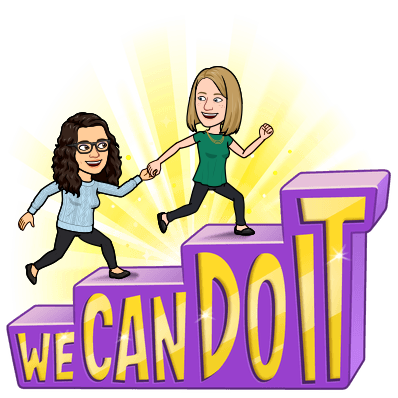
You don’t need to start big with mastery-based learning. This style of learning can be done without reinventing the wheel. It can be as simple as creating small quizzes, setting them up in your LMS so that there are questions pools that will select random questions. This will ensure that students will get different quiz versions should they require more than one mastery check. Do this for a few different topics or units as well.
Keep the window of time open for students so that they can attempt the quiz multiple times, having different questions each time. This exposes students to different questions, while also allowing them to practice and improve their skills.
You can even try out this approach with something as simple as one unit, or one week using stations (different activities) spread out around the classroom. Students can then take the time that they need to complete and learn the various tasks at each of the stations in the class.
Another example of starting small with mastery-based learning is targeting one specific skill or lesson for mastery. It doesn’t have to be a long term or all-encompassing implementation of mastery-based learning. Take that one skill or lesson, and have students work towards mastery, continuously revising until all of the students demonstrate that they know and understand that particular skill. You can then provide reach ahead for those that have demonstrated mastery and are ready to move on to a new challenge.
EdTech Tools & Mastery-Based Learning
Mastery-based learning lends itself well to the use of a variety of edtech tools. There are many different options available out there, so start with your goal or purpose, and go from there.
Learning Management Systems
Your LMS is a perfect place to set up mastery checks, and you don’t even have to mark them all! There are often self-marking quiz options that allow you to have students complete and submit them, without needing to sit down and mark them all.
Quizzing Tools
These tools are a perfect option for mastery checks in your classroom. You can set them up to mark automatically, or you can collect the data and assess it yourself. There are pros and cons to each option – it all comes down to what tool works best for you and your students.
Gamified Apps
There are so many gamified apps out there. By introducing some of these games, you are setting your students up well for mastery-based learning. Some of these tools have a homework mode that allows students to work their way through the lesson, with knowledge checks set up throughout.
We’ve also got a whole post dedicated to using game apps for student engagement, which goes into a lot more detail about how and why you’d want to select certain tools.
Many of these tools now offer more options versus the individual competition mode that we often think about when we discuss gamified apps, so be sure to check out the various options as you create activities for your students.
Additional Considerations for Mastery-Based Learning
Group vs Individual Work
Mastery-based doesn’t have to be students working alone. There is a lot of room for collaboration and working in groups. You can even use some of your students that are working ahead of pace to work with students that might be a little behind.
This isn’t a “every student for themselves” format, there are so many ways that you can get students working in pairs, groups, etc. Students at the same point can work together as well! There are lots of options. It gets students working with a variety of other people, which is great.
Culture of Revision
There may be a little more marking or feedback that you need to provide in order to get students to embrace this idea of revision. But have no fear, it doesn’t have to be a long or arduous task that you are marking. You can take a smaller piece of work, provide feedback, and then have students review and make changes based on that feedback.
Another important thing to keep in mind with this idea of assessing work is that not everything needs a formal mark! The idea isn’t to give every iteration a grade, but rather to provide feedback to then get students to go back and improve.
Once a student is ready, and has demonstrated mastery in the skills needed, then you are ready to assign a mark or grade. If you try to provide a grade too soon, students are more likely to shut down and not look for ways to improve. So focus on the feedback, and try to avoid assigning or suggesting a mark.
Keep Mastery Checks Short
Don’t pile on a lot of skills in a mastery check. Be intentional about what you are getting students to demonstrate, and keep it short!
When designing mastery checks, make sure you design it in such a way where you can have multiple versions that students could potentially complete. Based on how they do, make sure you send them back with feedback and some sort of lesson or activity that will allow them to do more learning in order to successfully learn that skill.
You can even send a video of you delivering a lesson with your feedback to really get students learning and going back to review and develop the skills to be successful. This mastery-based learning structure really allows teachers to differentiate for students.
How to Incorporate Mastery-Based Learning with Traditional Grading
While we aren’t going to get into this topic in detail today, the idea of grading and reporting in a traditional way doesn’t really make much sense! If students are demonstrating mastery as they work their way through a unit, course, etc. then what is the purpose of a unit test?!
Mastery-based learning definitely has a way of making you rethink all of your past practices, and how you can improve all of the processes involved in teaching.
Interested in Learning More About Mastery-Based Learning?
Check out the following articles to explore mastery-based learning in more detail:
